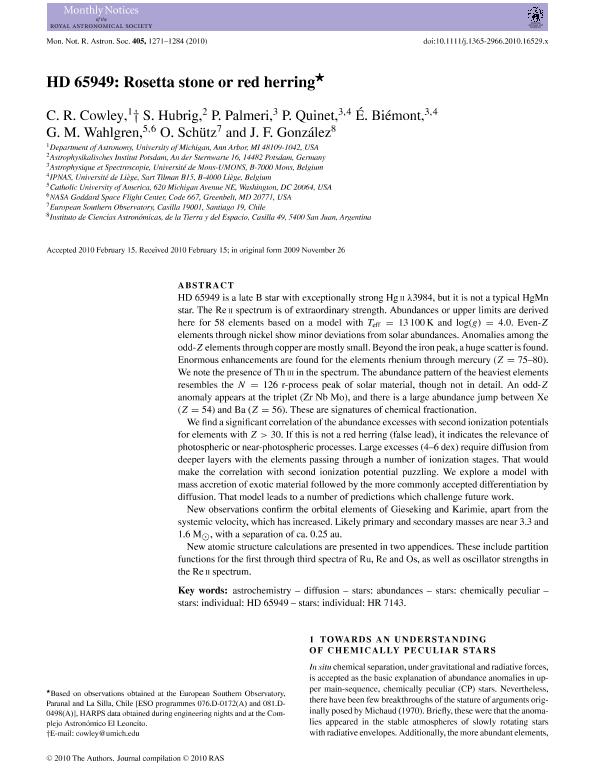Mostrar el registro sencillo del ítem
dc.contributor.author
Cowley, C. R.
dc.contributor.author
Hubrig, S.
dc.contributor.author
Palmeri, P.
dc.contributor.author
Quinet, P.
dc.contributor.author
Biémont, É.
dc.contributor.author
Wahlgren, G. M.
dc.contributor.author
Schütz, O.
dc.contributor.author
Gonzalez, Jorge Federico

dc.date.available
2017-02-14T18:51:33Z
dc.date.issued
2010-06
dc.identifier.citation
Cowley, C. R.; Hubrig, S.; Palmeri, P.; Quinet, P.; Biémont, É.; et al.; HD 65949: Rosetta stone or red herring; Oxford University Press; Monthly Notices Of The Royal Astronomical Society; 405; 2; 6-2010; 1271-1284
dc.identifier.issn
0035-8711
dc.identifier.uri
http://hdl.handle.net/11336/12982
dc.description.abstract
HD 65949 is a late B star with exceptionally strong Hg ii λ3984, but it is not a typical HgMn star. The Re ii spectrum is of extraordinary strength. Abundances or upper limits are derived here for 58 elements based on a model with Teff= 13 100 K and log (g) = 4.0. Even-Z elements through nickel show minor deviations from solar abundances. Anomalies among the odd-Z elements through copper are mostly small. Beyond the iron peak, a huge scatter is found. Enormous enhancements are found for the elements rhenium through mercury (Z= 75–80). We note the presence of Th iii in the spectrum. The abundance pattern of the heaviest elements resembles the N= 126 r-process peak of solar material, though not in detail. An odd-Z anomaly appears at the triplet (Zr Nb Mo), and there is a large abundance jump between Xe (Z= 54) and Ba (Z= 56). These are signatures of chemical fractionation.
We find a significant correlation of the abundance excesses with second ionization potentials for elements with Z > 30. If this is not a red herring (false lead), it indicates the relevance of photospheric or near-photospheric processes. Large excesses (4–6 dex) require diffusion from deeper layers with the elements passing through a number of ionization stages. That would make the correlation with second ionization potential puzzling. We explore a model with mass accretion of exotic material followed by the more commonly accepted differentiation by diffusion. That model leads to a number of predictions which challenge future work.
New observations confirm the orbital elements of Gieseking and Karimie, apart from the systemic velocity, which has increased. Likely primary and secondary masses are near 3.3 and 1.6 M⊙, with a separation of ca. 0.25 au.
New atomic structure calculations are presented in two appendices. These include partition functions for the first through third spectra of Ru, Re and Os, as well as oscillator strengths in the Re ii spectrum
dc.format
application/pdf
dc.language.iso
eng
dc.publisher
Oxford University Press

dc.rights
info:eu-repo/semantics/openAccess
dc.rights.uri
https://creativecommons.org/licenses/by-nc-sa/2.5/ar/
dc.subject
Astrochemistry
dc.subject
Diffusion
dc.subject
Stars:Abundances
dc.subject
Stars:Chemically Peculiars
dc.subject
Stars: Individual: Hd65949
dc.subject.classification
Astronomía

dc.subject.classification
Ciencias Físicas

dc.subject.classification
CIENCIAS NATURALES Y EXACTAS

dc.title
HD 65949: Rosetta stone or red herring
dc.type
info:eu-repo/semantics/article
dc.type
info:ar-repo/semantics/artículo
dc.type
info:eu-repo/semantics/publishedVersion
dc.date.updated
2017-02-13T20:30:23Z
dc.journal.volume
405
dc.journal.number
2
dc.journal.pagination
1271-1284
dc.journal.pais
Reino Unido

dc.journal.ciudad
Oxford
dc.description.fil
Fil: Cowley, C. R.. University Of Michigan; Estados Unidos
dc.description.fil
Fil: Hubrig, S.. Astrophysikalisches Institut Potsdam; Alemania
dc.description.fil
Fil: Palmeri, P.. Universite de Mons; Bélgica
dc.description.fil
Fil: Quinet, P.. Universite de Mons; Bélgica. Universite de Liege; Bélgica
dc.description.fil
Fil: Biémont, É.. Universite de Mons; Bélgica. Universite de Liege; Bélgica
dc.description.fil
Fil: Wahlgren, G. M. . Catholic University of America; Estados Unidos. National Aeronautics And Space Administration. Goddart Institute For Space Studies; Estados Unidos
dc.description.fil
Fil: Schütz, O. . European Southern Observatory; Chile
dc.description.fil
Fil: Gonzalez, Jorge Federico. Consejo Nacional de Investigaciones Cientificas y Tecnicas. Centro Cientifico Tecnologico San Juan. Instituto de Ciencias Astronomicas de la Tierra y del Espacio; Argentina
dc.journal.title
Monthly Notices Of The Royal Astronomical Society

dc.relation.alternativeid
info:eu-repo/semantics/altIdentifier/url/https://academic.oup.com/mnras/article/405/2/1271/1185259/HD-65949-Rosetta-stone-or-red-herring
dc.relation.alternativeid
info:eu-repo/semantics/altIdentifier/doi/https://doi.org/10.1111/j.1365-2966.2010.16529.x
dc.relation.alternativeid
info:eu-repo/semantics/altIdentifier/url/https://arxiv.org/abs/1002.2945
Archivos asociados
